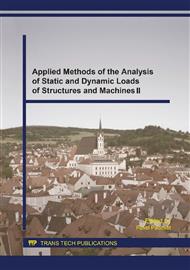p.340
p.344
p.348
p.352
p.359
p.367
p.371
p.375
p.379
Locking Compression Plate for Distal Tibia Fractures
Abstract:
This article represents a multidisciplinary approach to biomechanics (engineering + medicine) in the field of distal tibia fractures. The objective of the present study was to carry out a strength and reliability assessment of a medial plate for the treatment of distal tibia fractures. This was performed via numerical modelling (FEM) and experimental methods (compression test and Electronic Speckle Pattern Interferometry – ESPI method). The plate is used for internal fixation in orthopaedics and traumatology. Analyses were performed for non-fused bone with comminuted fracture in the distal metaphysis (i.e. unsuccessful treatment, where all loads in the metaphysis are carried by the plate). An anatomical tibia model (based on CT images in Mimics software) was used for FE analysis. In the experiments, the bone was replaced with a shaped piece of spruce wood (based on Mimics software) and the plate was loaded until its failure (major plastic deformation). Numerical and experimental results were evaluated and compared.
Info:
Periodical:
Pages:
359-366
Citation:
Online since:
February 2016
Keywords:
Price:
Сopyright:
© 2016 Trans Tech Publications Ltd. All Rights Reserved
Share:
Citation:


